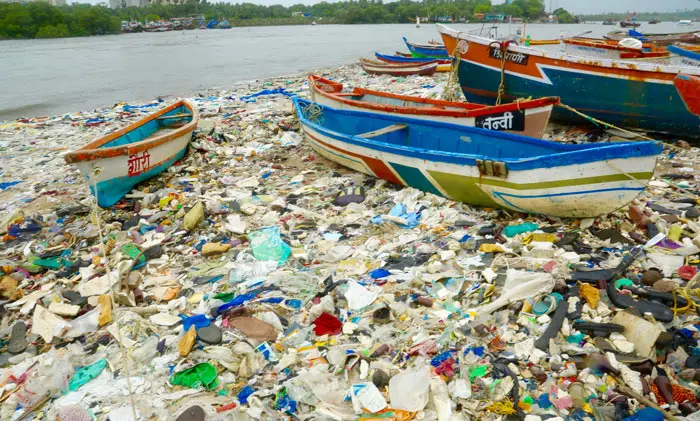Plastic Pollution is the accumulation and permeation of man-made plastics into the environment reaching a point when they wreak havoc on ecosystems and the wildlife that inhabit them. Plastic pollution is widespread throughout the planet ranging from the summit of the highest peak in the world, Mt. Everest, to the Mariana Trench, the deep point in our oceans.
All waterways on all continents lead to the ocean. Annually these global ‘aqueous highways’ carry millions of tons of human-generated plastic waste to oceans. The problem is getting worse each year.
More than 8 million tons of plastic enter the oceans each year, equal to dumping a garbage truck of plastic every minute. As much as 80 percent of all litter in our oceans is made of plastic. According to a report presented at the 2017 United Nations Marine Conference, as many as 51 trillion microplastic particles, 500 times more than the stars in our galaxy, litter our oceans and seas, seriously threatening marine wildlife.
There are five major ocean gyres: the North and South Pacific Subtropical Gyres, the North and South Atlantic Subtropical Gyres, and the Indian Ocean Subtropical Gyre. Multiple factors such as currents, winds, and planetary rotation contribute to predictable movements of ocean pollution which culminate in a central concentration of debris. These focal points are known as gyres.
Plastic debris is caught in these gyres and can be found clustered in the center of these whirls. These are not “islands of plastic” as is commonly thought, but an area of amassed plastic and a secondary problem of broken down microplastics creating an “ocean Slurpee” invisible to the human eye.
By 2050 if this rate of plastic pollution continues, there will be more plastic in the ocean than fish.

1. Ocean plastics are affecting yet unknown numbers of marine species. A recent study shows that at least forty percent of marine mammals and seabird species are affected by ingestion of inorganic plastics. Plastic waste kills up to one million seabirds, 100,000 sea mammals, marine turtles and countless fish each year. Plastic remains in our ecosystem for years, harming thousands of sea creatures every day ( United Nations Marine Conference, 2017).
2. Plastic doesn’t break down like other organic waste but turns into microplastics which is then easily mistaken by fish and invertebrates as plankton. The consumption of plastics by fish, caught for food for humans, allows plastics to travel up our food chain. Health consequences include ingesting the carcinogenic pollutants that attach to microplastics.
3. The half-life of commonly discarded plastics is still being debated. Factors such as ocean surge and ultraviolet light will accelerate the breakdown of the original product, but what remains are microplastics which can be readily consumed by plankton, fish larvae, invertebrates and begin working their way up the food chain until they end up on dinner platters in our favorite neighborhood seafood restaurant.
1. Ocean plastics are affecting yet unknown numbers of marine species. A recent study shows that at least forty percent of marine mammals and seabird species are affected by ingestion of inorganic plastics. Plastic waste kills up to one million seabirds, 100,000 sea mammals, marine turtles and countless fish each year. Plastic remains in our ecosystem for years, harming thousands of sea creatures every day ( United Nations Marine Conference, 2017).
2. Plastic doesn’t break down like other organic waste but turns into microplastics which is then easily mistaken by fish and invertebrates as plankton. The consumption of plastics by fish, caught for food for humans, allows plastics to travel up our food chain. Health consequences include ingesting the carcinogenic pollutants that attach to microplastics.
3. The half-life of commonly discarded plastics is still being debated. Factors such as ocean surge and ultraviolet light will accelerate the breakdown of the original product, but what remains are microplastics which can be readily consumed by plankton, fish larvae, invertebrates and begin working their way up the food chain until they end up on dinner platters in our favorite neighborhood seafood restaurant.
Advocacy Actions Sea Save Foundation actively seeks to change legislation by rallying constituents to contact their local representatives to sponsor or reject bills that have an impact on marine plastic pollution. One recent victory is AB 1884, a California bill to ban plastic straws.
Dive for a Difference Photography and video documenting ocean pollution problems is in demand. Images can help tell stories and stand witness to the detrimental effects plastic pollution has on our ocean environments. Daily throngs of SCUBA divers backroll into oceans armed with critical weapons, their cameras. Dive for a Difference creates a forum that will bridge a critical gap, providing a platform for these photographers and their images to help teachers, students, and scientists who need these images to complete their work.
Week in Review Every week we round up all the latest ocean-related news stories, summarize and consolidate. This collective, well-vetted publication “The Ocean Week in Review” raises awareness in an increasingly noisy and fast-paced world. We believe that informed advocates are best positioned to make a difference.
Sea Save Foundation is a 501 (c) 3 nonprofit organization EIN: 20-0403083. We received the GuideStar Platinum seal of approval in GuideStar’s Exchange program, meaning we have obtained their highest rating for transparency and legitimacy as an organization.



